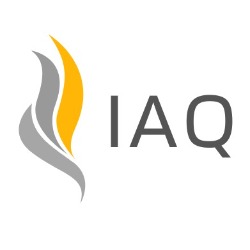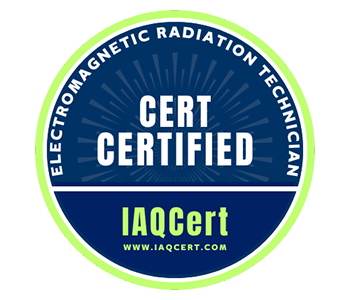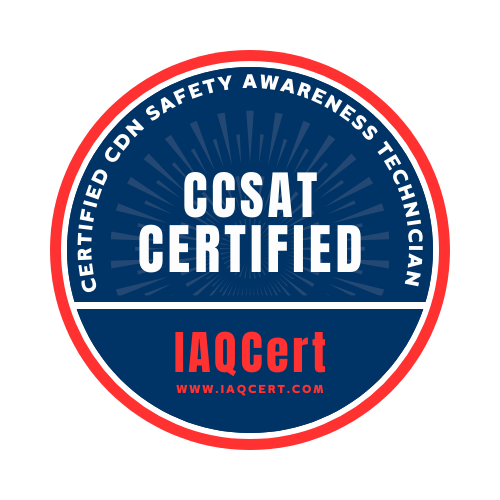Certified Canadian Safety Awareness Technician (CCSAT)
The Certified Canadian Safety Awareness Technician (CCSAT) course provides essential training in recognizing, assessing, and controlling workplace hazards across Canadian industries. The program follows national and provincial safety guidelines—focusing on hazard identification, risk analysis, and practical control strategies. Key topics include PPE use, lockout/tagout, hazard communication, and emergency procedures.
Participants build strong safety assessment skills, understand frameworks like OHSA, CNESST, and WorkSafeBC, and apply preventive measures in construction, service, and industrial settings.
Overview
Certification
As a CCSAT-certified technician, you bring measurable safety value to every Canadian job site.
This Assessment-Based Certificate (ABC) program validates your proven knowledge of Canadian safety regulations and best practices, strengthening your credibility with employers, clients, and inspectors. After passing the exam, you can proudly display your digital IAQCert badge on your resume, project bids, LinkedIn profile, or workplace safety board to showcase your verified professionalism and commitment to occupational health and safety.
Learning Approach
1. LearnEase
Ideal for newcomers or supervisors wanting structured training. Enjoy 33 engaging lessons across 12 modules—study at your own pace and revisit the content as a safety reference library.
2. CertFast
Designed for experienced professionals. Take a focused 1-hour proctored exam to validate your skills—skip the extended coursework and earn the badge fast.
Learning Outcomes
- Explain the mission of Canada’s occupational health and safety laws, including key principles from OHSA (Ontario), CNESST (Québec), and other jurisdictions.
- Identify physical, chemical, biological, ergonomic, and environmental hazards, and apply the hierarchy of controls.
- Understand Safety Data Sheets (SDS) and WHMIS/GHS labels under Canada’s Hazardous Products Regulations.
- Select, inspect, and maintain personal protective equipment (PPE), including basic awareness of respiratory protection.
- Outline lockout/tagout procedures and machine-guarding practices to control hazardous energy and moving parts.
- Apply best practices for ladder safety, walking-working surfaces, and fall prevention systems under Canadian standards.
- Describe the components of a compliant emergency response plan, including fire extinguisher use, evacuation, and first aid readiness.
- Recognize and mitigate hazards related to heat stress, noise, and indoor air quality in various workplace environments.
- Promote psychological health and safety by addressing harassment, stress, and violence prevention, following CSA Z1003 and provincial legislation.
Whether you choose the full learning path (LearnEase) or the fast-track exam (CertFast), CCSAT gives you the knowledge, recognition, and confidence to lead safety practices on Canadian job sites—from construction to industry to service sectors.
Enrollment & Certification Policy
Your enrollment includes full access to all course materials and the final exam for a three year from your original date of enrollment. Certification is awarded immediately upon successfully passing the exam, and it remains valid until three year’s from your initial enrollment date. Students who enroll in a Technician Certification may request one Safety course of their choice free of charge. Please contact IAQCert support to redeem.
Curriculum
Curriculum
- 13 Sections
- 33 Lessons
- 156 Weeks of Access
- Module 1: Canadian OHS Framework and Worker RightsThis module introduces key Canadian workplace safety concepts. It explains how the Internal Responsibility System (IRS) works, outlines the three basic rights of workers (to know, participate, and refuse unsafe work), and describes the duties of employers, supervisors, and workers, including due diligence. While similar to the U.S. version (CUSAT), this content is specific to Canadian laws. By the end, you'll understand how everyone in the workplace plays a role in safety.3
- Module 2: Hazard Identification, Risk Assessment & IRS in ActionThis module builds on what you learned in Module 1 by focusing on how to identify workplace hazards and assess risks before accidents happen. You’ll learn how to spot different types of hazards (physical, chemical, biological, ergonomic, and environmental), perform a Job Hazard Analysis (JHA), use a risk matrix to rank risks, and apply the hierarchy of controls. You'll also see how the Internal Responsibility System (IRS) works in real situations, showing how safety is a shared responsibility.3
- Module 3: Walking-Working Surfaces and Fall ProtectionThis module teaches practical fall prevention essentials. You’ll learn when guardrails or floor opening covers are legally required, including key height standards across provinces like BC and Ontario. It also covers safe ladder use, including the 4:1 setup rule and the three-point contact technique. Finally, you’ll be introduced to the basics of personal fall-arrest systems, the CSA Z259 standards, and how to properly use and inspect harnesses, lanyards, and anchor points.3
- Module 4: WHMIS 2015 and Hazard Communication for CCSATThis module introduces WHMIS 2015, Canada’s national system for classifying and communicating workplace hazardous materials. You’ll learn how to read labels and Safety Data Sheets (SDS), recognize hazard symbols, and understand your responsibilities under the law. Clear communication is key to preventing chemical-related incidents and protecting everyone on the job.2
- Module 5: Personal Protective Equipment (PPE) for CCSATIn this module, you'll learn when employers must provide and pay for PPE, how to conduct and document hazard assessments, and how to apply key CSA standards for eye, face, foot, and visibility protection. These skills ensure CCSAT professionals can manage PPE needs confidently and compliantly across Canadian workplaces.3
- Module 6: Respiratory Protection Program for CCSATThis module covers when and why respirators are needed, emphasizing their role as a last resort in hazard control. You’ll learn about key Canadian regulations, CSA Z94.4-18 standards, and how to implement a full Respiratory Protection Program. Topics include fit testing, proper respirator selection using APFs, cartridge change-out schedules, and essential care practices to ensure worker safety.2
- Module 7: Lockout/Tagout & Machine Guarding for CCSATThis module explains how to safely control hazardous energy using Lockout/Tagout (LOTO) procedures and proper machine guarding. You’ll learn the six-step energy isolation process, group lockout methods, types of machine guards, and when exceptions apply. Real case studies and Canadian standards like CSA Z460-20 help reinforce the importance of these core safety practices for all CCSAT professionals.2
- Module 8: Powered Mobile Equipment & Material Handling (CCSAT)In this module, you'll learn the certification requirements for forklift operators, including mandatory evaluations every three years. It also covers the forklift stability triangle, safe practices around mobile equipment, battery charging area precautions, and how to inspect pallet racking to prevent structural failures.3
- Module 9: Confined Space Awareness (CCSAT)This module explains what legally defines a confined space in Canada and why these areas pose serious risks. You'll learn when entry permits are required, how to test for safe air conditions, and the roles of each team member during entry. By the end, you'll be able to plan and manage confined space work safely and in full legal compliance.3
- Module 10: Environmental and Health Stressors for CCSATThis module explores how heat, cold, noise, and air quality affect worker safety. You’ll learn to prevent heat illness with the “Water–Rest–Shade” method, work safely in extreme cold and smoky conditions, and understand when noise levels require hearing protection programs. Real Canadian examples and regulations highlight how to manage these common workplace stressors.3
- Module 11: Emergency Preparedness and First Aid for CCSATThis module covers how to prepare for emergencies and respond effectively. You’ll learn how to create emergency plans, use fire extinguishers safely with the PASS method, and meet first aid kit and reporting requirements under Ontario’s Reg. 1101. Real examples and Canadian safety standards show how these measures protect workers and save lives.3
- Module 12: Psychological Health, Harassment & ViolenceThis module teaches how to recognize and address psychosocial hazards like bullying or excessive workload. You'll explore the CSA Z1003 standard, legal duties in Ontario and Québec, and how to build violence and harassment prevention programs. Real case examples and Canadian resources will help you support mental well-being in any workplace.3
- CCSAT CERTIFICATION EXAM5



